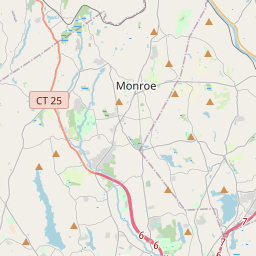Jehudi Ashmun
Historical marker location:
227 Grove Street, New Haven, Connecticut
( Marker is at the intersection of Grove Street and High Street on Grove Street.)







© OpenStreetMap contributors
Loading...
Searching for other points of interest within 3 miles of this location.The first telephone book was issued in New Haven, Connecticut in 1878. It contained just 50 listings.
About New Haven County
New Haven County Timeline
New Haven County, located in the state of Connecticut, has a rich and varied history that dates back to the early 17th century. The area was originally inhabited by the indigenous Quinnipiac tribe before the arrival of European settlers. In 1638, English Puritans led by Reverend John Davenport and Theophilus Eaton established a settlement in the area, which would later become the city of New Haven.
During the colonial period, New Haven County played a significant role in the development of the Connecticut Colony. The settlement grew rapidly and became a major center of trade and commerce. In 1701, the city of New Haven was officially chartered as a separate municipality, and Yale College, now known as Yale University, was founded in 1701. The college became a prestigious institution and helped solidify New Haven County's reputation as an intellectual and cultural hub.
New Haven County was also a prominent player in the American Revolutionary War. The region was heavily involved in the resistance against British rule, with notable figures like Benedict Arnold and Nathan Hale hailing from the area. The Battle of New Haven in 1779 saw British forces invade the city, but thanks to the local militia's resistance, the British troops were eventually repelled.
In the 19th and 20th centuries, New Haven County thrived as an industrial center, particularly in manufacturing. The region was known for its production of firearms, clocks, and rubber goods. The city of New Haven saw significant growth and urban development during this period, attracting immigrants from all over the world, especially from Italy and Ireland. Today, New Haven County remains an important part of Connecticut's history, with its architectural landmarks, cultural institutions, and vibrant communities.
During the colonial period, New Haven County played a significant role in the development of the Connecticut Colony. The settlement grew rapidly and became a major center of trade and commerce. In 1701, the city of New Haven was officially chartered as a separate municipality, and Yale College, now known as Yale University, was founded in 1701. The college became a prestigious institution and helped solidify New Haven County's reputation as an intellectual and cultural hub.
New Haven County was also a prominent player in the American Revolutionary War. The region was heavily involved in the resistance against British rule, with notable figures like Benedict Arnold and Nathan Hale hailing from the area. The Battle of New Haven in 1779 saw British forces invade the city, but thanks to the local militia's resistance, the British troops were eventually repelled.
In the 19th and 20th centuries, New Haven County thrived as an industrial center, particularly in manufacturing. The region was known for its production of firearms, clocks, and rubber goods. The city of New Haven saw significant growth and urban development during this period, attracting immigrants from all over the world, especially from Italy and Ireland. Today, New Haven County remains an important part of Connecticut's history, with its architectural landmarks, cultural institutions, and vibrant communities.
New Haven County Timeline
This timeline provides a concise overview of the key events in the history of New Haven County, Connecticut.
- 1638: The New Haven Colony was founded by English Puritans
- 1644: New Haven Colony becomes a part of the Connecticut Colony
- 1662: Connecticut Colony receives a Royal Charter, formalizing its existence
- 1722: New Haven County is established from the southwestern part of the Connecticut Colony
- 1764: The city of New Haven is incorporated
- 1885: The city of Waterbury is incorporated
- 1893: Hamden is incorporated as a town
- 1920: New Haven County experiences significant industrial growth
- 1954: Construction of the Connecticut Turnpike begins
- 1958: Yale University and the city of New Haven engage in urban renewal projects
- 1975: The Connecticut Post Mall opens in Milford
- 1990: The Peabody Museum of Natural History relocates to a new building at Yale
- 2005: New Haven celebrates the 350th anniversary of its founding